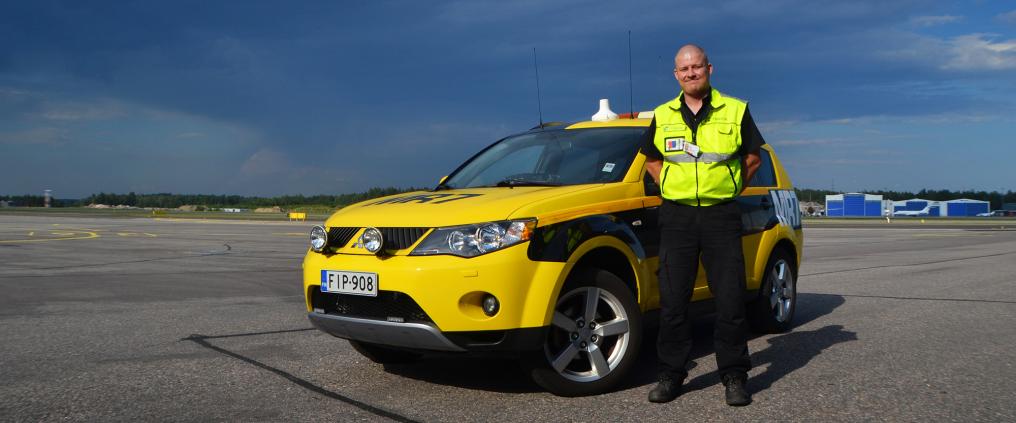Have you paid attention to the black-and-yellow vehicles driving at the airport, rushing to the aircraft ramps ahead of the aircraft? The vehicle is driven by one of the nine marshallers, or apron controllers, at Helsinki Airport. Timo Karonen is one of them.
Timo Karonen has worked as a marshaller for seven years, but he is one of the most junior marshallers. The team of marshallers is highly experienced, and the senior colleagues are always ready to assist their junior colleagues.
Since there are only nine marshallers, the team spirit is solid. The turnover is low, and the jobs are seldom available.
“You learn the job of a marshaller on the job. Depending on your previous experience at an airport, you first learn the job from a senior marshaller by working with him for about four months,” Karonen says.
Parking service 24/7
Marshallers direct the aircraft that are not using a jetway to the right aircraft ramp, and control ground traffic at the airport. The majority of the aircraft requiring directions are aircraft of foreign airlines, cargo planes, and business flights. Domestic airlines can taxi to some aircraft ramps themselves.
At the cargo apron, in practise all aircraft require marshallers, since the volume of the ground equipment is high, and it is good to ensure safe taxiing of the aircraft.
Marshaller will drive in front of the aircraft and take over giving the directions.
The busiest time for marshallers is usually afternoons and early evenings, when the majority of flights land. Some cargo planes arrive during the morning and evening, but the operations are less busy between 10 a.m. and midday. However, in practise, aircraft arrive at all hours of the day. Marshallers work in three shifts, and there are 1–3 marshallers on duty at the same time, depending on the traffic and time of the day.
Helsinki Airport is the only airport in Finland where there is a unit that specializes in directing aircraft. At the other Finavia airports, the operations are conducted alongside other duties. Unlike at several other international airports, Helsinki Airport does not charge for marshaller operations, as it is included in the landing fee.
Directions by car and with hand signals
In the front seat of a marshaller's vehicle, there is a wide range of various equipment that transmit information on landing and airborne aircraft, and air traffic control's instructions. The ground traffic radar provides information on traffic at the entire apron.
“There is a parking plan for all the aircraft, drafted by the Apron Control unit, out of which the marshaller picks his aircraft,” Karonen says.
When the aircraft arrives at the taxiway, the marshaller drives in front of the aircraft, and picks it to be directed to the aircraft ramp. When the aircraft is approaching the aircraft ramp, the marshaller gets out of the vehicle, and directs it to the final stopping point with hand signals.
“It is possible to have radio contact with the aircraft, but usually that is necessary only in exceptional situations. The air traffic control gives the aircraft instructions for taxiing, and the order to follow the marshaller. From that point onwards, air traffic control gives taxiing instructions only to us,” Karonen says.
Traffic control and assistance in problem situations
Traffic control at the airport is also an important part of a marshaller's work. They make sure that the speed limit and rules are observed. Moreover, they provide assistance in different problem situations, and in malfunction of passenger boarding bridges, or even go pick up a newspaper blowing in the wind at the runway.
A marshaller has to always be ready to react to rapidly changing situations, and for example in crash situations, a marshaller is usually the first to be called. The marshaller is able to arrive at the scene fast, and evaluate what to do and who to call: service, maintenance, the police, or the rescue services.
“When the phone rings, you can never know what it is about.”
Experience is crucial when solving problem situations. Decisions have to be made fast, and aim at continuing as safe and fluent operations of the airport as possible. In this, cooperation with other operators is also essential.
According to Karonen, the work is at its most challenging when weather and visibility are poor, and the aircraft has to be directed for example to an unfamiliar and narrow spot.
“However, these situations bring also the greatest experiences of success. Now, after seven years, the work has become routine, so that surprises rarely happen. But when the phone rings, you can never know what it is about,” Karonen points out.



